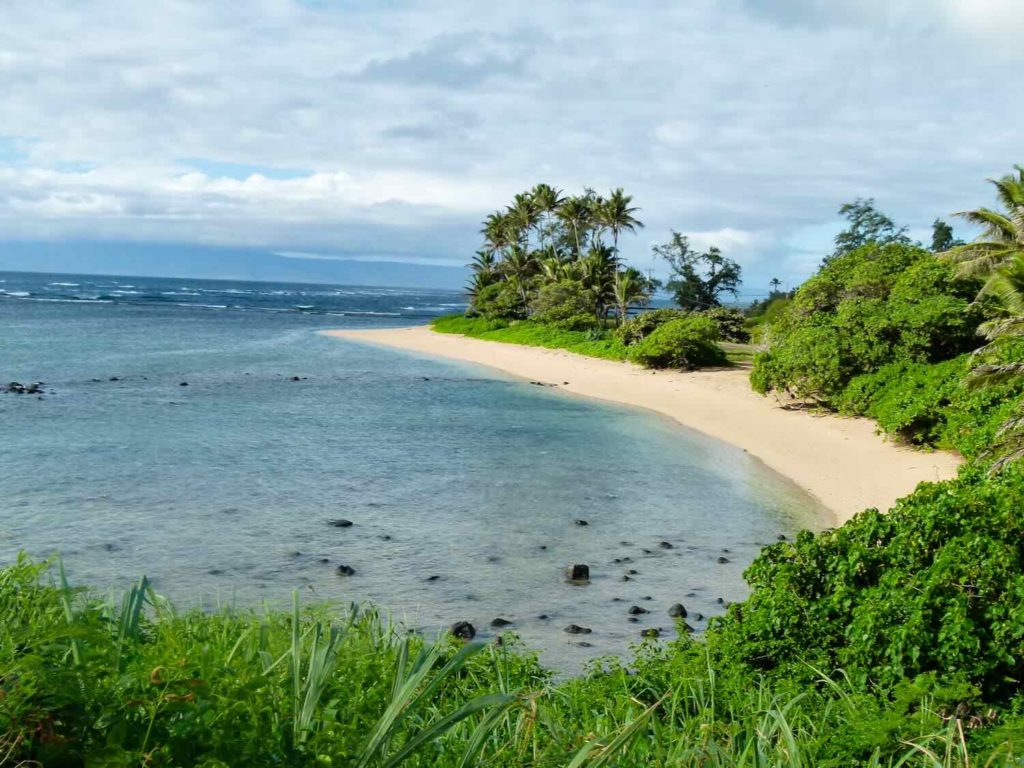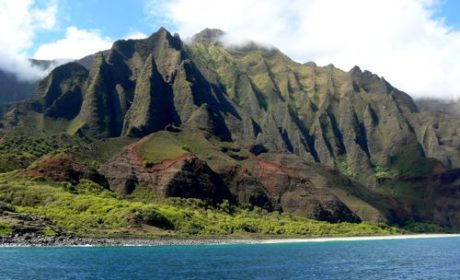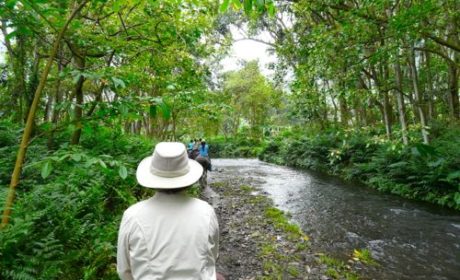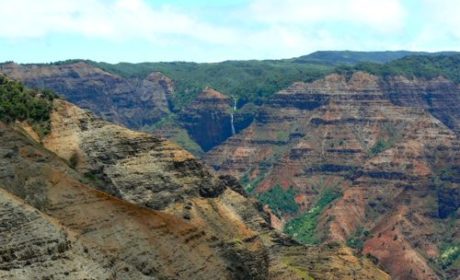Are you a fan of uncrowded beaches, each one different from the other? Spend a couple of days at the best Molokai beaches during your trip to Hawaii. On my visits to this Hawaiian island, I discovered why the beaches on Molokai definitely deserve a spot on your active travel in Hawaii itinerary.
The Hawaiian island of Molokai is home to the world’s tallest sea cliffs rising between 3,600 and 3,900 ft. above the ocean. And history buffs will be fascinated by fishponds that date back to ancient times. But it’s the variety of beaches that call my name.

I much prefer exploring beaches to baking all day on a lounge by the water’s edge. Blame it on my run-ins with skin cancer or maybe it’s an overactive curiosity.
The first time we visited Molokai, Alan and I explored beaches on both the West and East sides of the island, but we didn’t have time to see all of them. On my latest trip sponsored by the Molokai Visitors Bureau, I discovered more secluded beaches to add to my list of Molokai beach favorites.
Table of Contents
Two-day Molokai itinerary to see the best beaches
I recommend dividing your Molokai beach hopping into two days of sand and surf. Spend one day exploring the rugged beaches on the West side. The ocean’s rough here, so this adventure is more about exploring the scenery and taking gorgeous photos.
On a second day later in your trip, experience the East side’s sandy coves and reef-protected waters. This is your opportunity to swim and snorkel.
Molokai has dozens of secluded beaches and I can’t claim to have visited every one of them. But these are my favorites based upon my experiences beach hopping on Molokai. And, remember, although all beaches in the state of Hawaii are public, respect private property where marked.
Boomer Travel Tip
Plan your trip with our Hawaii Travel Planner.
Molokai’s West side beaches are for exploring
Treeless grazing lands seem to stretch to the sea on Molokai’s West side. Large homes are tucked here and there, with a sprinkling of small condo developments, if you know where to look. It’s drier on this side of the island and there is no reef protecting the shoreline.
Explorers will find a series of unique beaches, some with camping facilities. Crowds? I’ve never experienced any on these Molokai beaches.
The surf is rough and there are no lifeguards so be cautious swimming at West side beaches.
Papohaku Beach

On the times that I’ve visited Papohaku Beach, my footprints were the only ones that decorated the golden sands that stretch for three miles along Molokai’s West side. Many beach aficionados consider Papohaku to be the best beach on Molokai.
And this lovely wide stretch of sand has made Dr. Beach’s list of best beaches on more than one occasion. It’s the perfect sandy spot to spend the day walking, relaxing, reading a book and enjoying a picnic lunch. Look for the signs on Kalukoi Rd. directing you to Papohaku.
You’ll also find campsites (fee charged) and a public restroom at Papohaku Beach Park at one end of the beach.
Paka’a Beach

On my visit to Paka’a Beach, black lava rocks, wet from the surf, shimmered in the sun. The rocky beach makes an interest photography shoot.
It’s a good spot for watching whales swimming in the Kaiwi Channel during the winter season. Although I saw a group of locals snorkeling and spear fishing, these waters are not for novices or those unfamiliar with the conditions.
Reaching Paka’a Beach is part of the adventure. It’s located between Po’olau Beach and DixieMaru Beach (Kapukahehu) with access from Pohakuloa Rd. There is no sign for Paka’a Beach so take a chance—turn on a road toward the beach (unless it’s marked private) and explore!
Kephui Beach

Most visitors to Kephui Beach arrive at the defunct Kephui Beach Resort to watch the local surf action. But I prefer arriving at the southern end of the beach via Kaiaka Rd.
Walking down the path to Kephui Beach, the sounds of waves crashing against rocks alert me to the fact that this isn’t a swimming beach. But there are many rocky ledges with tide pools that are fun to explore. Aikaka Rock looms at the end of the beach. I could spend hours here exploring and taking photos.

If you’re up for a hike, a trail leads from the main section of Kephui Beach across a grassy hillside to cliffside views of the two Pohaku Mauliuli beaches. On my visit, I watch as two boys play behind the large rocks of the first Pohaku beach. They bravely stand up when waves approach, then crouch down to shield themselves from the water’s force as it crashes over them.
Molokai’s East side beaches are for snorkeling and swimming
Palm trees hang over curves of sandy beaches on Molokai’s East side. If you’re a swimmer or snorkeler here’s your chance to enjoy reef protected waters. Although I’ve never seen crowds on any Molokai beach, East side beaches are definitely more popular, partly because they are less isolated than the West side and also because of the protective reef.
Kumimi Beach

Standing at the overlook for Kumimi Beach, I can’t imagine a more perfect tropical paradise. You’ll find this lovely slice of sand on Highway 450 (Kamehameha Highway), 20 miles from Kunakaikai, Molokai’s major town. Kumimi is also known as Murphy’s Beach or Twenty Mile Beach. Calm waters allow for good snorkeling when the tide is mid to high levels.
Sandy Beach

This small pocket of beach is located about a mile beyond Kumimi Beach. Alan and I spent a relaxing afternoon at Sandy Beach on our first visit to Molokai. It has a reputation as a safe swimming beach except when there’s a south swell. The beach is protected by a reef and has a relatively rock-free entrance into the water, which your feet will appreciate.
Halawa Beaches: Kama’alaea and Kiwilli

Located at the end of Highway 450 (Kamehameha Highway), Kama’alaea and Kiwilli beaches are worth the scenic drive to Halawa Valley where these two beaches are located. Part of Halawa Beach Park, the sandy coves sit at the mouth of the Halawa Valley, a privately owned piece of paradise, which can be visited on a cultural tour through Halawa Valley Falls Cultural Hike.
Kama’alaea offers shallow waters that are mostly safe for swimming. But you may find the water murky as the Halawa stream empties mountain rainwaters into the ocean near this spot. Watch out for a strong rip current if the surf is strong.

Black lava rock decorates Kawillli Beach making it one of my favorite beach photography locations on Molokai. Although it’s possible to swim here—beware of strong currents if there’s a strong surf—I find that it’s a beach for watching and thinking.
Historians believe that the first Polynesians settled in Hawaii on this very spot in 650 A.D. And in 1946, a tremendous tidal wave thundered more than a mile into Halawa Valley, destroying nearly everything in its path. So bring a beach chair and picnic lunch, then settle in to see if history speaks to you at Kawilli Beach.
Where to stay on Molokai
Molokai offers a laid back travel approach. You won’t find any resorts, golf courses or high-end dining. Hotel Molokai is the island’s only hotel. Staying there is like going back to the 1950’s.
Simple, but comfortable, rooms cluster near a pool or the Pacific Ocean. The dining room is excellent, although it does not offer breakfast.
Alan and I dream about booking a Molokai vacation rental to turn our next visit into a writer/photographer retreat. We’ll explore, hike, check out where the locals eat on a true slow travel adventure.
If you’re looking for a day or two of beach hopping on Molokai, my suggestions should keep you busy. And since I haven’t chronicled every single beach on the island, let me know if you find a favorite that you think I should know about.
Disclosure: Molokai Visitors Bureau introduced me to some of the beaches in this article. As always, the opinions are my own.



